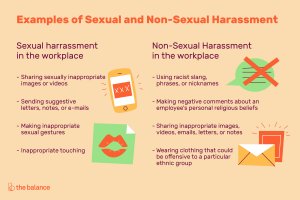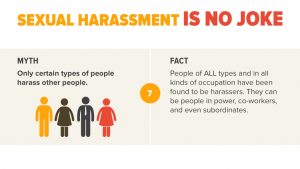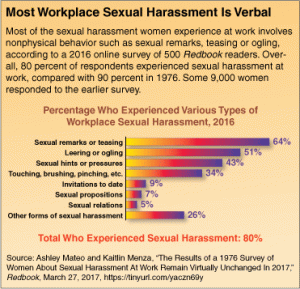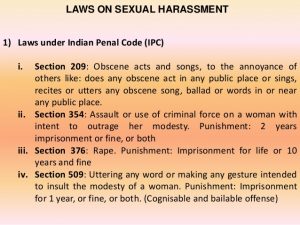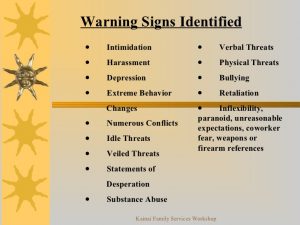What is Sexual Harassment
What?
The EEOC has defined sexual harassment in its guidelines as:
Unwelcome sexual advances, requests for sexual favors, and other verbal or physical
conduct of a sexual nature when:
- Submission to such conduct is made either explicitly or implicitly a term or condition of an individual’s employment, or
- Submission to or rejection of such conduct by an individual is used as a basis for employment decisions affecting such individual, or
- Such conduct has the purpose or effect of unreasonably interfering with an individual’s work performance or creating an intimidating, hostile, or offensive working environment.
Unwelcome Behavior is the critical word. Unwelcome does not mean “involuntary.” A victim may consent or agree to certain conduct and actively participate in it even though it is offensive and objectionable. Therefore, sexual conduct is unwelcome whenever the person subjected to it considers it unwelcome. Whether the person in fact welcomed a request for a date, sex oriented comment, or joke depends on all the circumstances.
Source: Preventing Sexual Harassment (BNA Communications, Inc.) SDC IP .73
1992 manual
- Sexual harassment includes many things…
- Actual or attempted rape or sexual assault.
- Unwanted pressure for sexual favors.
- Unwanted deliberate touching, leaning over, cornering, or pinching.
- Unwanted sexual looks or gestures.
- Unwanted letters, telephone calls, or materials of a sexual nature.
- Unwanted pressure for dates.
- Unwanted sexual teasing, jokes, remarks, or questions.
- Referring to an adult as a girl, hunk, doll, babe, or honey.
- Whistling at someone.
- Cat calls.
- Sexual comments.
- Turning work discussions to sexual topics.
- Sexual innuendos or stories.
- Asking about sexual fantasies, preferences, or history.
- Personal questions about social or sexual life.
- Sexual comments about a person’s clothing, anatomy, or looks.
- Kissing sounds, howling, and smacking lips.
- Telling lies or spreading rumors about a person’s personal sex life.
- Neck massage.
- Touching an employee’s clothing, hair, or body.
- Giving personal gifts.
- Hanging around a person.
- Hugging, kissing, patting, or stroking.
- Touching or rubbing oneself sexually around another person.
- Standing close or brushing up against a person.
- Looking a person up and down (elevator eyes).
- Staring at someone.
- Sexually suggestive signals.
- Facial expressions, winking, throwing kisses, or licking lips.
- Making sexual gestures with hands or through body movements.
Examples
VERBAL
- Referring to an adult as a girl, hunk, doll, babe, or honey
- Whistling at someone, cat calls
- Making sexual comments about a person’s body
- Making sexual comments or innuendos
- Turning work discussions to sexual topics
- Telling sexual jokes or stories
- Asking about sexual fantasies, preferences, or history
- Asking personal questions about social or sexual life
- Making kissing sounds, howling, and smacking lips
- Making sexual comments about a person’s clothing, anatomy, or looks
- Repeatedly asking out a person who is not interested
- Telling lies or spreading rumors about a person’s personal sex life
NON-VERBAL
- Looking a person up and down (Elevator eyes)
- Staring at someone
- Blocking a person’s path
- Following the person
- Giving personal gifts
- Displaying sexually suggestive visuals
- Making sexual gestures with hands or through body movements
- Making facial expressions such as winking, throwing kisses, or licking lips
PHYSICAL
- Giving a massage around the neck or shoulders
- Touching the person’s clothing, hair, or body
- Hugging, kissing, patting, or stroking
- Touching or rubbing oneself sexually around another person
- Standing close or brushing up against another person
Terminology
SEXISM is an attitude. It is an attitude of a person of one sex that he or she is superior to a person of the other sex. For example, a man thinks that women are too emotional. Or a woman thinks that men are chauvinists.
SEX DISCRIMINATION is a behavior. It occurs when employment decisions are based on an employees sex or when an employee is treated differently because of his or her sex. For example, a female supervisor always asks the male employees, in a coed workplace, to move the boxes of computer paper. Or, a male supervisor always asks the female employees, in a coed workplace to plan office parties.
SEXUAL HARASSMENT is a behavior. It is defined as unwelcome behavior of a sexual nature. For example, a man whistles at a woman when she walks by. Or a woman looks a man up and down when he walks towards her.
SUBTLE SEXUAL HARASSMENT is a behavior but not a legal term. It is unwelcome behavior of a sexual nature that if allowed to continue could create a QUID PRO QUO and/or a Hostile Work Environment for the recipient. For example, unwelcome sexual comments, jokes, innuendoes.
QUID PRO QUO HARASSMENT is when employment and/or employment decisions for an employee are based on that employees’s acceptance or rejection of unwelcome sexual behavior. For example, a supervisor fires an employee because that employee will not go out with him or her.
HOSTILE WORK ENVIRONMENT is a work environment created by unwelcome sexual behavior or behavior directed at an employee because of that employee’s sex that is offensive, hostile and/or intimidating and that adversely affects that employee’s ability to do his or her job. For example, pervasive unwelcome sexual comments or jokes that continue even though the recipient has indicated that those behaviors are unwelcome.

